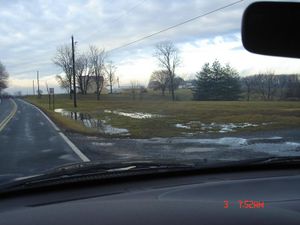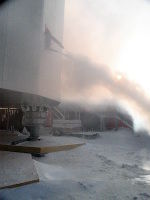Precision rain
Precision rain is an uncommon form of precipitaion. Rarely seen, it's formation is the result of a very specific set of conditions. Precision rain can be more clearly defined as: 'Rain, or precipitation that has fallen from the sky to the earth by means of a precision rain cloud, or precision cyclone. There are a few different forms of precision rain, each with their own stories, and special abilities. Each year, Precision rain accounts for over $1.5 billion Canadian dollars ($3 US) of damage worldwide.[1]
Precision Rain: The Unnatural menace[edit | edit source]
Precision rain is essentially the same thing as normal rain - it is falling water formed by the process of evaporation of water from lakes, oceans, plant life, and Oprah Winfrey's ever-watery eyes. From there, the water vapour develops into the cloud, via the way most terrestrial clouds form, and then falls, under the influence of Gravity.
To be defined as Precision rain, the rainfall must have the following attributes:
- Actual rainfall must be less than 10 meters squared
- Generally, no-one must have seen the rainfall.
- In the possibility of someone watching the rainfall, it must rain solely on them.
Vary rarely does precision rain exceed more than 5 mm of rainfall. In the event of it doing so, flash flooding is unlikely, due to the nature of precision rain taking up only 10 metres of space. What may result is Flash Puddling. Though dangerous, it's not quite as bad as flooding. Techniques to deal with this are covered later this article.
By Convention, Precision Rain is classed under a few main types:
- Orthographic
- Planometric
- Isometric
- Parallel
- Cyclic
Orthographic Precision Rain[edit | edit source]
Orthographic rain is the most common type of precision rain, comprising nearly 80% of all precision rain systems. It is mostly characterized by the bizarre effect of it's 2D projections. As the rain falls, it leaves a 2D projection of the rain on the ground, a precursor to where the puddles will form. Some have called these weird projections 'shadows', or 'It's the fucking rain blocking the light, idiot', but most leading precision rain-analysts doubt this terminology will gain acceptance.
Planometric Precision Rain[edit | edit source]
Planometric Precision rain is the next most common form, accounting for 10% of precision rain. In this form, the wind shear splits the rain into having 30 degree angles to the ground upon striking, causing large amounts of puddle water to splash up and hit bystanders in the face. This kind of precision rain only usually occurs in the presence of humans, in order to not violate the watching person principle (described above). In absence of a viewer, planometric forms will revert to Orthographic or Parallel.
Isometric Precision rain[edit | edit source]
The classification of Isometric Precision rain is under a fair amount of criticism and controversy in modern times. The reason being that it is identical to Planometric in all regards except for two details:
- It occurs when there is minimal veiwers present (the rainfall is most efficient with one bystander)
- It's angle of attack, er reflection is at 45, not 30 degrees.
The most accepted explanation for the differences, is that since less people are present, the rainfall is not forced to 'divide and conquer' - that is, it has more rain to attack less people with, and with greater precision. In recognition of this, Dr M J Robertson, PhD, of the McCarthy institute for the training of tactical rainfall states "The real thing to be questioned here is not whether the rain does this because of that, or the other thing. The real problem here is the naming conventions. By stagnating about the nomenclature of the cloud form, we are splitting this country in two. East on West, Catholic on Protestant. Oh God, what are we doing?" Due to the higher water pressure, victims of this form tend to suffer from perforated ear-drums, haemorrhaging, concussion, and in some (uncommon) instances, death. Currently, this type makes up 8% of recorded precision rain.
Parallel precision rain[edit | edit source]
Parallel Precision rain, much rarer than the previously discussed forms, accounts for approximately 1.9% of all precision rain-falls. Widely regarded as being fortunate for its rareness, a parallel precision rainfall is a deadly foe, the level 78 paladin of the precision rainfalls. As the name indicates, the rainfall itself is almost completely at a 90 degree angle to regular rainfall. This sideways rain is usually the result of freak wind conditions or cyclonic systems. Occaisionally, parallel rainfalls are recorded in very close vicinity to tornadoes, in which case, it forms more of a spiral rain - with speeds in excess of 160 km/h. Many deaths are the result of parallel rain, such as the Princess Diana[2]. If you encounter parallel rain yourself, these handy survival tips will help:

- Stop
- Drop
- Cover yourself. A blanket will do fine. If you don't have anything, try to do the first two steps near some sort of wall, or small hedge
If you have applicated these steps properly, the rain will go right over the top of you, or in the very least, bounce harmlessly off. The physics of this protection method are beyond the scope of the article.
Cyclic precision rain[edit | edit source]
Commonly confused for parallel rain stuck in a tornado, cyclic rain, also none as 'Hard (precision) Rain' is the worst type of precision rain possible. It accounts for only one in one-thousand rainfalls, and it's effects are widely disrupting, resulting in widespread deaths and building failures. The most famous 'Hard Rain' incident was the release of the Bob Dylan album titled 'hard rain'. A cascade of events followed:
- US and Canadian governments delcare martial law, state of emergency
- 10,000 die on either side of the atlantic
- Most of Europe follows and declares state of emergency
- By the end of the year, most countries were in anarchy, the economy was in free-fall, and reports that hard-rain had spread to the southern hemisphere has started to trickle in.
In many countries, this event is now known as S-13, synonmous with S-11 for the amount of terror caused. World-wide aid releif the following year was the highest ever, recorded as 3.2 billion Euros, at a time when the euro wasn't even conceived. Such was the economic depravities caused by Bob Dylan's Soft-selling Hard Rock failure.
Precision rain in Culture[edit | edit source]
Due to the terrifying threat that precision rain poses to all people across the globe, and the people of this planet have adjusted to that. Precision rain resulted in the invention of rooves, to block out surprise showers. Later on, the same methodology was applied to parallel rain, and walls were built. Many critics claim that these common elements of housing were the result of guarding against more mundane things, like regular rain, but these ideas have been widely dismissed as 'stupid', 'idiotic', and 'strangely arousing'. Precision rain has also come to be represented in symbology in some more obscure cultures.
The north American tribes[edit | edit source]
The Indians of North America had special symbology for Precision rain, passed down through the generations to serve as a warning, and a sign, so that they may be protected against precision rain's undesirable effects. Notice that the precision raincloud has much less cloud, and has scary lighting strikes down the side. Such use of lightning strikes were possibly used to scare little children and kittens. These symbols, due to the de-population of the Indian tribes, serve as a solemn reminder that people should listen to their parents when the white-devil precision rain comes to kill you.
Rain in aboriginal culture[edit | edit source]

The aboriginals of Australia have many references to precision rain in their culture. They believe it is regularly produced by the 'Rainbow Serpent', which in the summer, stretches out across the Pilbara, Arnhem Land and Cape York Peninsula (before the White Fella came in and called it the monsoon trough). Their core belief is that the Rainbow Serpent created the world by throwing it up, and this can be taken as an analogy for a raincloud 'throwing up' (precipitating) water, which then 'creates the world' (by nourishing plant and animal life). In Aboriginal art, there is many drawings of dead people, and this is believed to be paying homage to the unfortunates that have died as a result of being caught in precision rain.
Flash Puddling[edit | edit source]
Flash Puddling, not be confused with flash poodling, is a common result of precision rain. Similar to flash flooding, it is the very quick accumulation of water in an isolated area, leading to the quick development of dangerous puddles. Such puddles are deadly to wildlife such as ants, beetles, and spiders. Also, they tend to attract swarms of small children with gumboots. These children are ferocious animals with giant rending claws and flexing talons comparable to a raptors, and they can easily eat a man whole. The easiest way to avoid being killed by puddles is to avoid places that are:
- Outdoors
- Exposed to any rainfall, ever
- Populated by children with gumboots
- Populated by Raptors
- Anywhere
See Also[edit | edit source]
References[edit | edit source]
- ↑ No reference; no-one really cares about Canada.
- ↑ How else was rain going to get inside a tunnel?






